roadtripper
Well-known member
A few years ago, I read an article in one of the popular adventure magazines—it was probably NG Adventure or Backpacker, but I can’t recall—that talked about the top ten national park day hikes. This article mentioned Half Dome and compared it to a few other trails that I had already done in previous trips out west, such as Angel’s Landing and The Narrows in Zion, and the South Kaibab Trail at the Grand Canyon. Seeing Half Dome compared to these other fantastic hikes made me want to plan a trip out to Yosemite. Before this article, I had never heard of Half Dome, even though I had been to Yosemite for a few days back in 2003 and had been on some of the trails that are used to approach the dome. It took me a few years to return, but four friends and I finally made a trip back to the national park this past July.
The general advice you’ll read in guidebooks and on the nps.gov website is that you should start your hike of Half Dome as soon as possible to “avoid the crowds”. I’ll be honest – there is no avoiding the crowds here from June all the way to September. We arrived at the trailhead early at 5:30am on a Tuesday to avoid having to wait for the first shuttle of the day (7am) and to try to beat the crowds up to the famous Half Dome “cables”. What we found is that a hundred or so others had the same idea; the parking lot was already pretty full. This didn’t bother us a whole lot, though. It was Yosemite after all, and we knew better than to expect this trail to be quiet.
After a quick Jetboil breakfast in the parking lot, we started our 17-mile round trip hike at around 6am. The hike began with a 0.5 mile road walk to the actual trailhead at Happy Isles. We started the official trail, which immediately started moderately climbing along a paved path. Eventually, you lose the pavement and take a left turn onto the Mist Trail, a fantastic route that passes by 317-foot Vernal Falls, and later, 594-foot Nevada Falls. Each of these waterfalls is spectacular and world-class in its own right. This part of the hike is the Mist Trail, named that way because of a constant spray from Vernal Falls that you can’t avoid for a section of about a hundred feet or so. You don’t get soaked through by the mist, so I’m assuming that most find this section to be refreshing—we certainly did. It does make for tricky photography though, as your camera lens does get immediately wet. We saw a lot of hikers along this section, perhaps a hundred or two. A lot of them weren’t actually climbing Half Dome, though. Instead, they were doing an easier day hike loop back to Happy Isles, using the John Muir Trail as a descent route.
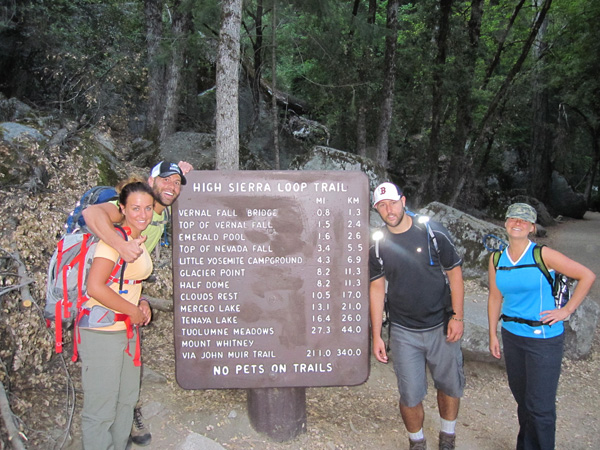
Above Nevada Falls, the trail continues upstream along the Merced River and eventually passes a spur trail to the Little Yosemite Valley backcountry campsite. The trail to Half Dome continues left. This section is relatively easy, with some shade and no scrambling or big steps involved. A few miles beyond the campsite you reach the base of the “sub-dome” of Half Dome. The trail gets challenging here, as it switchbacks very steeply for a few hundred feet to the top of the sub-dome. Surprisingly, we found a little bit of exposure here—certainly enough for us and many others to notice it. The climb up this sub-dome is exhausting since there is full exposure to the sun and the fact that you’ve already climbed about 7.5 miles and 4000 feet just to get to the base of it. Two of us, myself included, had to take breaks every two or three minutes. Once you reach the top of the sub-dome, the views are mesmerizing. You’ve got fantastic granite-infused views in all directions, as well as the first close-up views of the Half Dome cables. It offered the best views of granite I’ve seen anywhere, hands down.

I had seen many pictures of the Half Dome cables on the internet, but I couldn’t believe how much steeper they were in person. Without the cables, the route would be a solid Class 5. With the cables, it’s probably still the equivalent of a tough Class 3. At its steepest point, the cables are probably about 55 or 60 degrees in slope.
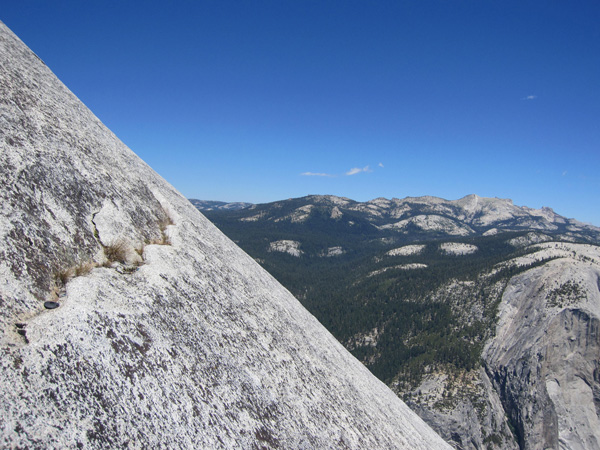
The cable system is reasonably well constructed though. There are two cables that run parallel up the entire side of the dome. They are spread about four feet apart—just wide enough to allow a train of hikers up and down at the same time. Every 20 feet or so along the cables, there are two metal poles that sink a foot or two into the granite that have a perpendicular piece of wood connecting them at your feet. These wood beams, which are tied around the poles by metal wiring, allow you to rest or wait for other hikers to safely pass you. Without these beams, the cables would be significantly more difficult and dangerous. A few of the metal poles are loose though, and one or two of them seemed like they could be easily pulled out. To be honest, I’m almost shocked that the National Park service has installed such a challenging and potentially dangerous cable system, knowing full well that many inexperienced hikers and climbers were going to use it. I’m glad they still allow this despite the potential legal liability they are taking by having it. I would not be surprised at all if they removed this system during our lifetime. It has to be the riskiest national park-supported trail in existence (far more risky than Angel’s Landing in my opinion).
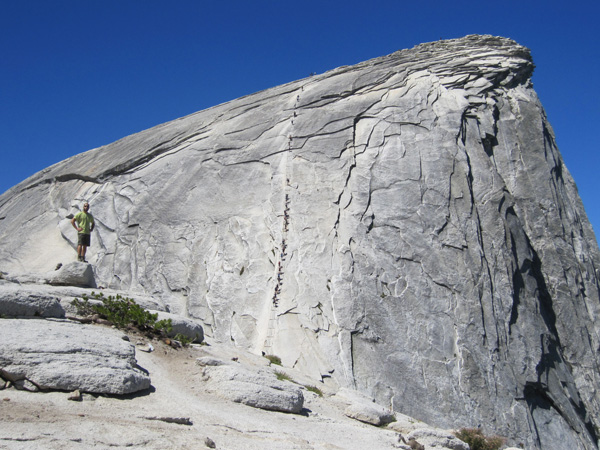
With the amount of people going up and down the cables, it is really amazing that so few have gotten hurt or died here over the years. Hiker traffic jams are extremely common—especially on the weekends. The park has just instituted a new permit system to restrict the number of Half Dome-ers to 500 per-day on Fridays, Saturdays, Sundays and Holidays. It seemed as though about one in ten or fifteen people on the cables we saw were freaking out and causing traffic jams. Sometimes, the jam would only last seconds, but one lasted about 3 or 4 minutes. People started getting upset by this lack of movement. A select few actually left the safety afforded by being between the cables and climbed up and down on the outside of one of the cables. This move has caused several accidents in the past, but luckily there were no close calls today. As absurd as this may sound to many of you, I couldn’t help but compare our experience on the cables to experiences by mountaineers on the Hillary Steps of Mount Everest. I can only imagine the frustration that Everest climbers must experience when they are stuck in a dicey position because of others. We all got moderately frustrated by the other hikers that were clearly too far outside their comfort zone. It was uncomfortable for us to be so exposed and not moving for minutes at a time. Some other hikers got the point where they would shout at others to speed things up.
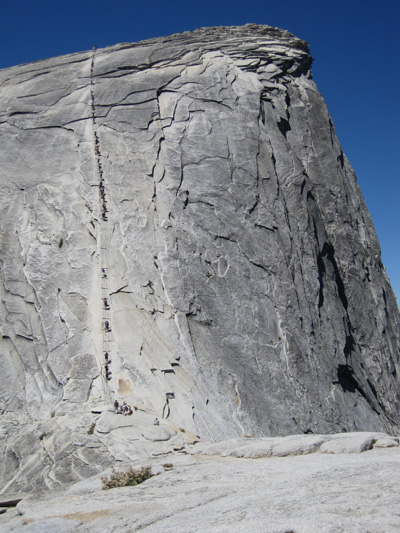
The views from the top of Half Dome are excellent.
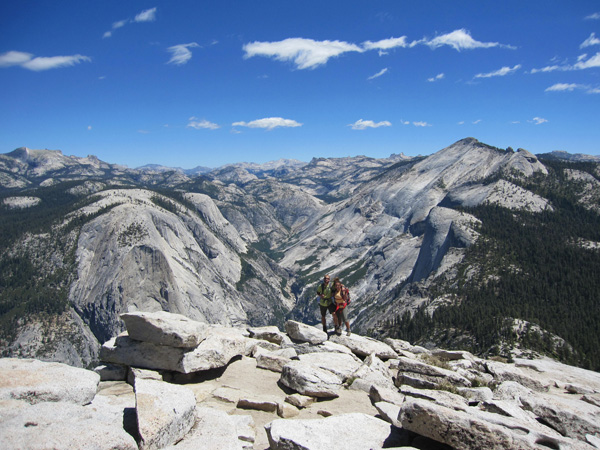
There are some guidebook authors that knock the views, but that just isn’t fair in our opinion. This hike is a classic and I don’t think there is any argument about it. Most of the fun of this hike is actually in the climb up the cables, though. You could almost say that the summit is anti-climactic, but the views are too impressive for me to completely feel that way. The summit is absolutely massive. No matter how many people are on the very top, it really wouldn’t ever feel too crowded in my opinion. Altogether, I’d estimate that 400 people climbed Half Dome this day.
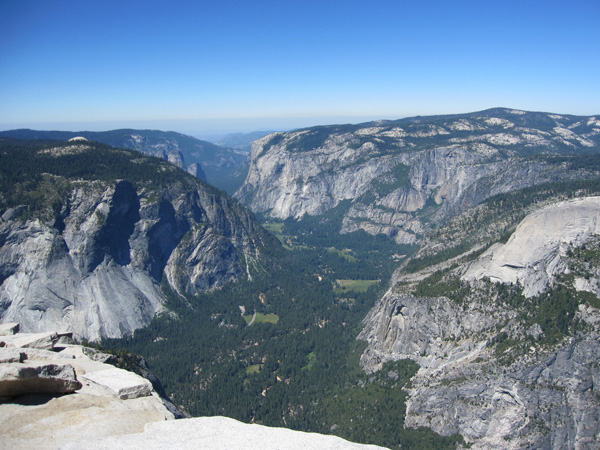
The trip down from Half Dome seemed to take forever. For one, the cables had wiped all of us out going up them. It was a real leg and forearm workout for each of us. The cables were also just as exhausting coming down because you had to really hold on tightly to the cables, especially during the traffic jams if you got caught between the relative safety of the metal poles.
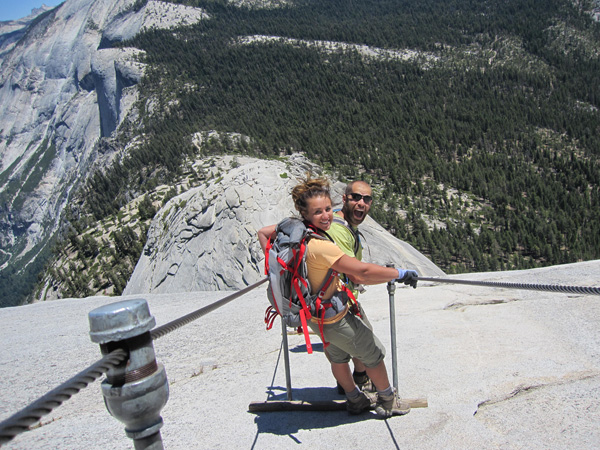
From the summit, it’s an 8.5 mile slog back to the car. The elevation loss is 4,800 feet, so it hurts a bit. Of course the temperature keeps climbing as you descend too, and it probably hit around 88 degrees on our way down. Even though we all brought 5 or 6 liters of water each on this hike, we all ran out with between two and four miles left. We took the John Muir Trail on the way down and saw this fantastic view:
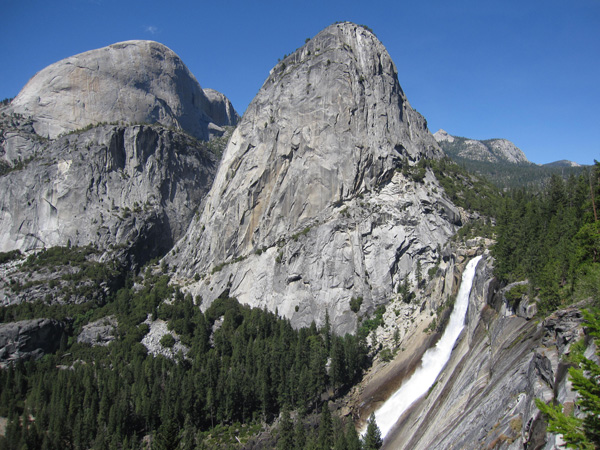
We were all pretty beat up by the time we reached the Happy Isles trailhead. Nobody was excited about that last 0.5 miles road walk along the shuttle road. In conclusion, we all loved Half Dome (and the rest of Yosemite for that matter). Half Dome is definitely a “bucket list” hike and undeniably one of the best features of the park.
The general advice you’ll read in guidebooks and on the nps.gov website is that you should start your hike of Half Dome as soon as possible to “avoid the crowds”. I’ll be honest – there is no avoiding the crowds here from June all the way to September. We arrived at the trailhead early at 5:30am on a Tuesday to avoid having to wait for the first shuttle of the day (7am) and to try to beat the crowds up to the famous Half Dome “cables”. What we found is that a hundred or so others had the same idea; the parking lot was already pretty full. This didn’t bother us a whole lot, though. It was Yosemite after all, and we knew better than to expect this trail to be quiet.
After a quick Jetboil breakfast in the parking lot, we started our 17-mile round trip hike at around 6am. The hike began with a 0.5 mile road walk to the actual trailhead at Happy Isles. We started the official trail, which immediately started moderately climbing along a paved path. Eventually, you lose the pavement and take a left turn onto the Mist Trail, a fantastic route that passes by 317-foot Vernal Falls, and later, 594-foot Nevada Falls. Each of these waterfalls is spectacular and world-class in its own right. This part of the hike is the Mist Trail, named that way because of a constant spray from Vernal Falls that you can’t avoid for a section of about a hundred feet or so. You don’t get soaked through by the mist, so I’m assuming that most find this section to be refreshing—we certainly did. It does make for tricky photography though, as your camera lens does get immediately wet. We saw a lot of hikers along this section, perhaps a hundred or two. A lot of them weren’t actually climbing Half Dome, though. Instead, they were doing an easier day hike loop back to Happy Isles, using the John Muir Trail as a descent route.

Above Nevada Falls, the trail continues upstream along the Merced River and eventually passes a spur trail to the Little Yosemite Valley backcountry campsite. The trail to Half Dome continues left. This section is relatively easy, with some shade and no scrambling or big steps involved. A few miles beyond the campsite you reach the base of the “sub-dome” of Half Dome. The trail gets challenging here, as it switchbacks very steeply for a few hundred feet to the top of the sub-dome. Surprisingly, we found a little bit of exposure here—certainly enough for us and many others to notice it. The climb up this sub-dome is exhausting since there is full exposure to the sun and the fact that you’ve already climbed about 7.5 miles and 4000 feet just to get to the base of it. Two of us, myself included, had to take breaks every two or three minutes. Once you reach the top of the sub-dome, the views are mesmerizing. You’ve got fantastic granite-infused views in all directions, as well as the first close-up views of the Half Dome cables. It offered the best views of granite I’ve seen anywhere, hands down.

I had seen many pictures of the Half Dome cables on the internet, but I couldn’t believe how much steeper they were in person. Without the cables, the route would be a solid Class 5. With the cables, it’s probably still the equivalent of a tough Class 3. At its steepest point, the cables are probably about 55 or 60 degrees in slope.

The cable system is reasonably well constructed though. There are two cables that run parallel up the entire side of the dome. They are spread about four feet apart—just wide enough to allow a train of hikers up and down at the same time. Every 20 feet or so along the cables, there are two metal poles that sink a foot or two into the granite that have a perpendicular piece of wood connecting them at your feet. These wood beams, which are tied around the poles by metal wiring, allow you to rest or wait for other hikers to safely pass you. Without these beams, the cables would be significantly more difficult and dangerous. A few of the metal poles are loose though, and one or two of them seemed like they could be easily pulled out. To be honest, I’m almost shocked that the National Park service has installed such a challenging and potentially dangerous cable system, knowing full well that many inexperienced hikers and climbers were going to use it. I’m glad they still allow this despite the potential legal liability they are taking by having it. I would not be surprised at all if they removed this system during our lifetime. It has to be the riskiest national park-supported trail in existence (far more risky than Angel’s Landing in my opinion).

With the amount of people going up and down the cables, it is really amazing that so few have gotten hurt or died here over the years. Hiker traffic jams are extremely common—especially on the weekends. The park has just instituted a new permit system to restrict the number of Half Dome-ers to 500 per-day on Fridays, Saturdays, Sundays and Holidays. It seemed as though about one in ten or fifteen people on the cables we saw were freaking out and causing traffic jams. Sometimes, the jam would only last seconds, but one lasted about 3 or 4 minutes. People started getting upset by this lack of movement. A select few actually left the safety afforded by being between the cables and climbed up and down on the outside of one of the cables. This move has caused several accidents in the past, but luckily there were no close calls today. As absurd as this may sound to many of you, I couldn’t help but compare our experience on the cables to experiences by mountaineers on the Hillary Steps of Mount Everest. I can only imagine the frustration that Everest climbers must experience when they are stuck in a dicey position because of others. We all got moderately frustrated by the other hikers that were clearly too far outside their comfort zone. It was uncomfortable for us to be so exposed and not moving for minutes at a time. Some other hikers got the point where they would shout at others to speed things up.

The views from the top of Half Dome are excellent.

There are some guidebook authors that knock the views, but that just isn’t fair in our opinion. This hike is a classic and I don’t think there is any argument about it. Most of the fun of this hike is actually in the climb up the cables, though. You could almost say that the summit is anti-climactic, but the views are too impressive for me to completely feel that way. The summit is absolutely massive. No matter how many people are on the very top, it really wouldn’t ever feel too crowded in my opinion. Altogether, I’d estimate that 400 people climbed Half Dome this day.

The trip down from Half Dome seemed to take forever. For one, the cables had wiped all of us out going up them. It was a real leg and forearm workout for each of us. The cables were also just as exhausting coming down because you had to really hold on tightly to the cables, especially during the traffic jams if you got caught between the relative safety of the metal poles.

From the summit, it’s an 8.5 mile slog back to the car. The elevation loss is 4,800 feet, so it hurts a bit. Of course the temperature keeps climbing as you descend too, and it probably hit around 88 degrees on our way down. Even though we all brought 5 or 6 liters of water each on this hike, we all ran out with between two and four miles left. We took the John Muir Trail on the way down and saw this fantastic view:

We were all pretty beat up by the time we reached the Happy Isles trailhead. Nobody was excited about that last 0.5 miles road walk along the shuttle road. In conclusion, we all loved Half Dome (and the rest of Yosemite for that matter). Half Dome is definitely a “bucket list” hike and undeniably one of the best features of the park.
Last edited:























![Grand Canyon, North and South Rims [Grand Canyon National Park] (National Geographic Trails Illustrated Map)](https://m.media-amazon.com/images/I/419Y-ycyVUL._SL500_.jpg)







![Yellowstone National Park [Map Pack Bundle] (National Geographic Trails Illustrated Map)](https://m.media-amazon.com/images/I/51kGuJ72qjL._SL500_.jpg)







![Grand Teton Day Hikes and National Park Map [Map Pack Bundle] (National Geographic Trails Illustrated Map)](https://m.media-amazon.com/images/I/41DB0jvRnbL._SL500_.jpg)




















